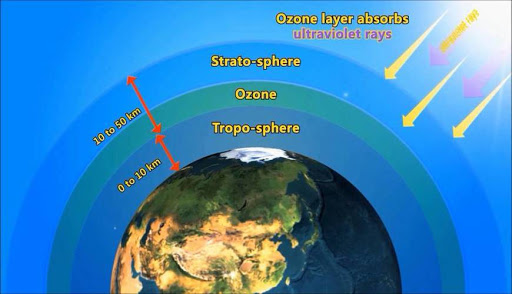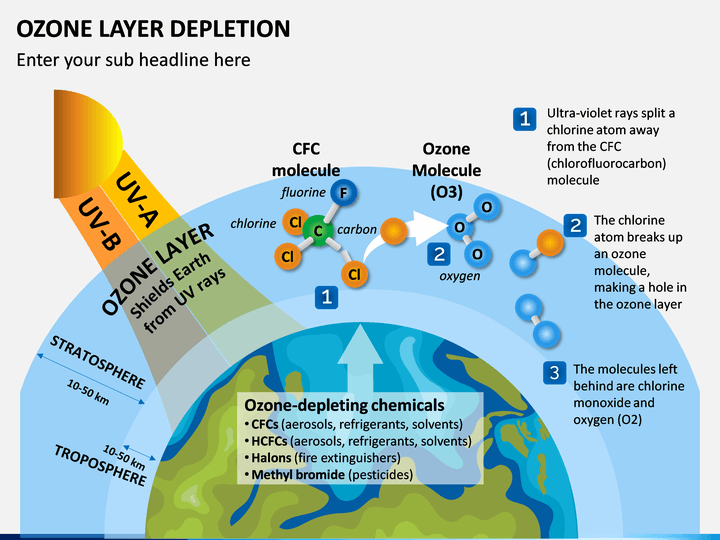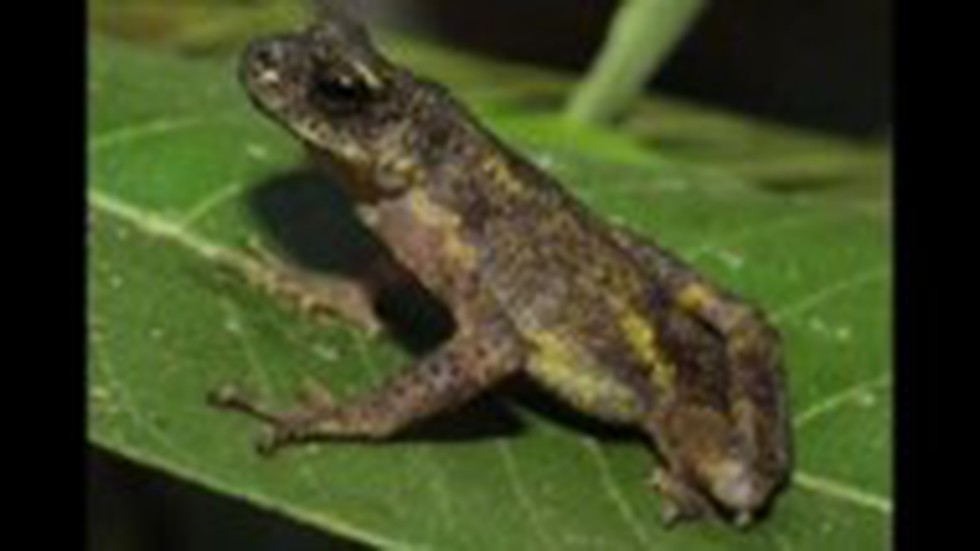CONTENTS
- Ozone hole detected over Antarctica
- Over The Top (OTT) Platforms
- Aerosols
- New toad species
- Diverse Epigenetic Epidemiology Partnership (DEEP)
Ozone Hole Detected Over Antarctica
Context:
Satellite measurements over Antarctica have detected a giant hole in the ozone layer.
Relevance:
GS I- Geography
Dimensions of the Article:
- What is Ozone Layer and what are Ozone Holes?
- Ozone creation and destruction
- Ozone Holes Grow and Shrink Every Year
- Causes of the Giant Ozone Hole in 2023
- Is Climate Change Reopening Ozone Holes?
What is Ozone Layer and what are Ozone Holes?
- Ozone layer, also called ozonosphere, is a region of the upper atmosphere, between roughly 15 and 35 km (9 and 22 miles) above Earth’s surface which contains relatively high concentrations of ozone molecules (O3).
- Approximately 90 percent of the atmosphere’s ozone occurs in the stratosphere, the region extending from 10–18 km (6–11 miles) to approximately 50 km (about 30 miles) above Earth’s surface.
- The ozone layer effectively blocks almost all solar radiation of wavelengths less than 290 nanometres from reaching Earth’s surface, including certain types of ultraviolet (UV) and other forms of radiation that could injure or kill most living things.

What are Ozone Holes?
- The ‘ozone hole’ is not really a hole — it refers to a region in the stratosphere where the concentration of ozone becomes extremely low in certain months.
- The ‘ozone holes’ most commonly talked about are the depletions over Antarctica, forming each year in the months of September, October and November, due to a set of special meteorological and chemical conditions that arise at the South Pole, and can reach sizes of around 20 to 25 million sq km.
- Such holes are also spotted over the North Pole, but owing to warmer temperatures than the South Pole, the depletions here are much smaller in size.
Ozone creation and destruction
- The production of ozone in the stratosphere results primarily from the breaking of the chemical bonds within oxygen molecules (O2) by high-energy solar photons. This process, called photodissociation, results in the release of single oxygen atoms, which later join with intact oxygen molecules to form ozone.
- The amount of ozone in the stratosphere varies naturally throughout the year as a result of chemical processes that create and destroy ozone molecules and as a result of winds and other transport processes that move ozone molecules around the planet.
- Over the course of several decades, however, human activities substantially altered the ozone layer.
- Ozone depletion, the global decrease in stratospheric ozone observed since the 1970s, is most pronounced in polar regions, and it is well correlated with the increase of chlorine and bromine in the stratosphere.
- Those chemicals, once freed by UV radiation from the chlorofluorocarbons (CFCs) and other halocarbons (carbon-halogen compounds) that contain them, destroy ozone by stripping away single oxygen atoms from ozone molecules.
- As the amount of stratospheric ozone declines, more UV radiation reaches Earth’s surface, and scientists worry that such increases could have significant effects on ecosystems and human health.

Ozone Holes Grow and Shrink Every Year:
- The size of the ozone hole over Antarctica changes annually, typically opening in August and closing in November or December.
- It’s caused by special winds over Antarctica due to the Earth’s rotation, creating a shield over the continent that prevents mixing with surrounding air. When the winds calm down, the hole closes.
Causes of the Giant Ozone Hole in 2023:
- The large ozone hole this year may be linked to volcanic eruptions at Hunga Tonga in Tonga during December 2022 and January 2023.
- Normally, gas from volcanic eruptions stays below the stratosphere, but this one released a lot of water vapor into the stratosphere.
- The water vapor, through chemical reactions, impacted the ozone layer and altered its heating rate. It also contained elements like bromine and iodine that can deplete ozone.
- There isn’t strong evidence to attribute this ozone hole to human activities.
Is Climate Change Reopening Ozone Holes?
- Ozone depletion isn’t a primary driver of global climate change, but rising temperatures could have an influence on ozone holes.
- Mitigation efforts for ozone holes were effective since the 1980s, but the 2020 and 2021 ozone holes were unusually deep and long-lasting, with wildfires in southeastern Australia contributing to the 2020 hole.
- The impact of ozone holes on Earth’s climate is not entirely clear; some data suggests they might have cooling effects by reducing the greenhouse gas effect.
-Source: The Hindu
Over The Top (OTT) Platforms
Context:
The Telecom Disputes Settlement Appellate Tribunal (TDSAT) has determined that Over The Top (OTT) platforms such as Hotstar fall under the jurisdiction of the Information Technology Rules, 2021, which are governed by the Ministry of Electronics and Information Technology (MeitY). This means that the regulation of OTT platforms is not within the purview of the Telecom Regulatory Authority of India (TRAI).
Relevance:
GS II: Polity and Governance
Dimensions of the Article:
- Controversy Over OTT Platform Regulation
- About OTT Services
- Importance of Regulation of OTT Communication Services
Controversy Over OTT Platform Regulation:
- A conflict has arisen between the Ministry of Communications (MoC) and the Ministry of Electronics and Information Technology (MeitY) over who should regulate Over-The-Top (OTT) platforms.
- This includes a debate on the regulatory framework for Internet-based communication services in India.
Conflict Between MoC and MeitY:
- The Department of Telecommunications (DoT), a part of the MoC, wanted to classify OTT platforms as telecommunications services and regulate them like traditional telecom operators.
- Separately, the Telecom Regulatory Authority of India (TRAI) issued a consultation paper on how to regulate OTT platforms.
Disagreement of IT Ministry with DoT:
- The MeitY believes that under the Allocation of Business Rules, Internet-based communication services fall outside of the DoT’s jurisdiction.
- The main focus of this disagreement is on OTT communication services like WhatsApp.
TRAI’s Attempt at Regulating OTT Services:
- Initially, TRAI recommended not creating a specific regulatory framework for OTT communication services like WhatsApp, Zoom, and Google Meet.
- However, TRAI has since revisited its stance and initiated consultations on how to regulate these services, causing further conflict with other ministries and departments.
About OTT Services:
- OTT services are online content providers that offer standalone streaming media products.
- They encompass various types of services, including video-on-demand platforms, audio streaming, messaging services, and internet-based voice calling solutions.
Popularity of OTT Services in India:
- OTT services have gained significant popularity in India, particularly during the Covid-19 pandemic.
- These services have been widely used as people sought online entertainment and communication options.
Impact of Data Usage:
- OTT services heavily rely on data usage to deliver their content.
- In India, monthly wireless data usage has experienced a remarkable growth of approximately 156 times from 2014 to 2022.
Shift in Revenue Generation:
- Traditional revenue sources such as voice calls and SMS have been superseded by data usage due to the rise of OTT services.
- With the increasing reliance on OTT platforms, revenue generation has shifted towards data usage.
Importance of OTT Services:
- OTT services have transformed the way people consume media and communicate by providing convenient and flexible options.
- Users can access a wide range of content and personalize their viewing experiences across multiple devices.
Regulatory Considerations:
- The rapid growth of OTT services has prompted discussions about regulations to address consumer protection, content censorship, and fair competition.
- Governments and regulatory bodies are exploring frameworks to balance these concerns with the promotion of innovation and creativity in the OTT sector.
Current Regulatory Status of OTT Communication Services in India:
- As of now, there is no specific regulatory framework for OTT communication services in India.
- The Telecom Regulatory Authority of India (TRAI) has issued consultation papers on this issue but has not made any final recommendations or regulations.
- In September 2020, TRAI recommended against regulatory intervention, stating that it should be left to market forces.
- However, it emphasized the need for monitoring and intervention at an appropriate time.
- The Department of Telecommunication (DoT) suggested TRAI to establish a suitable regulatory mechanism and consider selective banning of OTT services.
Importance of Regulation of OTT Communication Services:
- Leveling the playing field between Telecom Service Providers (TSPs) and OTT platforms is important.
- TSPs are regulated by laws and regulations, pay fees, and adhere to quality standards to provide voice and SMS services.
- In contrast, OTT platforms offer similar services without facing these requirements, giving them an advantage.
- Regulation is necessary to ensure fair competition and protect the revenue and profitability of TSPs and the government’s revenue from the telecom sector.
- Regulating OTT communication services is crucial for national security and public order.
- Enforcing lawful interception and monitoring by security agencies helps prevent the spread of misinformation, incitement of violence, or facilitation of criminal activities.
- Holding OTT platforms responsible for illegal content or activities on their platforms helps maintain a safe and secure online environment.
-Source: Indian Express
Aerosols
Context:
A new analysis by the Indian Space Research Organisation’s (ISRO) Physical Research Laboratory has shown that the Hindu Kush-Himalaya-Tibetan Plateau region has been witnessing an alarming increase in aerosol levels.
Relevance:
GS III: Environment and Ecology
Dimensions of the Article:
- Aerosols: Tiny Particles in the Air
- Impact of Aerosols on Climate
Aerosols: Tiny Particles in the Air
- Aerosols are minuscule solid or liquid particles present in the atmosphere, whether as natural occurrences like fog or volcanic emissions, or artificial ones like fossil fuel smoke.
- They can be primary aerosols, emitted directly into the air, or secondary aerosols, formed in the atmosphere from precursor gases.
- Aerosol particles are numerous, often composed of various inorganic and organic substances, and their size can vary widely, typically ranging from a few millimicrometres to 1 micrometre in diameter.
Types of Aerosols
- Aerosols with diameters less than 0.1 micrometre are known as Aitken nuclei.
- Common visible forms of atmospheric aerosols include smoke, smog, haze, and dust.
Impact of Aerosols on Climate
- Aerosols, such as dust, play a crucial role in the precipitation process by providing nuclei for condensation and freezing.
- They affect the climate by either reflecting or absorbing incoming solar radiation, thereby influencing the brightness and reflectivity of clouds.
- While reflection reduces sunlight at the ground level, the enhanced atmospheric heating can eventually warm the surface, counteracting the cooling effect of reflection.
- Aerosols also participate in chemical processes and influence the electrical properties of the atmosphere.
-Source: Hindustan Times
New Toad Species
Context:
A group of scientists from India and the United Kingdom have discovered a new species of toads – Bufoides bhupathyi in Dampa tiger reserve of Mizoram.

Relevance:
GS III: Environment and Ecology
Dimensions of the Article:
- New Toad Species
- Dampa Tiger Reserve
New Toad Species
- The newly discovered toad species belongs to the Bufoides genus.
- This genus is exclusively found in a narrow region in northeast India.
- The newly identified species displays distinctive features like interdigital webbing, skin coloration, tuberculation, and the presence of ovoid, tuberculated, and depressed parotid glands.
- It is the third species within the Bufoides genus, with the previous two, Bufoides meghalayanus and Bufoides kempi, discovered in Meghalaya.
- The newly discovered species has been named after S. Bhupathy, a renowned herpetologist.
Dampa Tiger Reserve
- Located in the western Lushai Hills of Mizoram, the Dampa Tiger Reserve was declared a tiger reserve as part of the Project Tiger initiative in 1994.
- It shares its western boundary with the Chittagong hill tracts, particularly the Sazek hill range in Bangladesh.
- The reserve features hilly terrain with elevations ranging from 49 to 1095 meters above sea level. Prominent peaks include Chhawrpialtlang (1095m), Dampatlang (869m), and Pathlawilunglentlang (780m).
- The vegetation in the reserve varies from tropical evergreen to semi-evergreen forests.
- The reserve is drained by the River Khawthlangtuipui in the West and the Teirei River in the East, with tributaries like Keisalam, Seling, and Aivapui flowing through it.
- Dampa Tiger Reserve is home to diverse wildlife, including Hoolock Gibbons, Macaques (Rhesus, Assamese, Pig-Tailed, Stump-Tailed), and Phayre’s Leaf Monkeys.
- Rich flora in the reserve includes species like Dipterocarpus turbinatus, Dipterocarpus marcocarpus, Terminalia myriocarpa, and Michelia champaca.
-Source: Hindustan Times
Diverse Epigenetic Epidemiology Partnership (DEEP)
Context:
The CSIR-Centre for Cellular and Molecular Biology (CSIR-CCMB), Hyderabad, is set to be part of the Diverse Epigenetic Epidemiology Partnership (DEEP).
Relevance:
GS III: Science and Technology
Dimensions of the Article:
- Diverse Epigenetic Epidemiology Partnership (DEEP)
- DNA Methylation
Diverse Epigenetic Epidemiology Partnership (DEEP)
- DEEP is a comprehensive genomics and epigenomics study focused on unraveling the genetic factors contributing to Non-Communicable Diseases (NCDs) in diverse populations, with a particular emphasis on South Asians.
- This five-year international project aims to investigate the impact of genetic and environmental diversity on disease risk across populations globally, including regions in Asia, Africa, and North and South America.
- Researchers will analyze individuals from various genetic and environmental backgrounds to identify DNA methylation patterns associated with disease risk in each context.
- The study will create software, infrastructure, and employ advanced statistical analyses to generate new resources, which will complement existing international health and genetics databases, providing insights into DNA methylation variation.
Significance:
- DEEP research will shed light on shared and unique disease-causing mechanisms across different populations and regions.
- It will address questions related to the effectiveness of medicines developed in one region for other populations.
- Ultimately, the DEEP study aims to facilitate targeted interventions and treatments, reducing global health disparities and inequities.
DNA Methylation
- DNA methylation is a biochemical process in which chemical groups attach to DNA, influencing the activation and deactivation of genes.
- It falls under the category of epigenetic modifications and enables the body to respond to environmental cues, playing a vital role in overall health and disease conditions.
- Understanding the intricate relationships between DNA methylation, genetics, and the environment is crucial for comprehending the pathways of health and disease.
-Source: The Hindu





